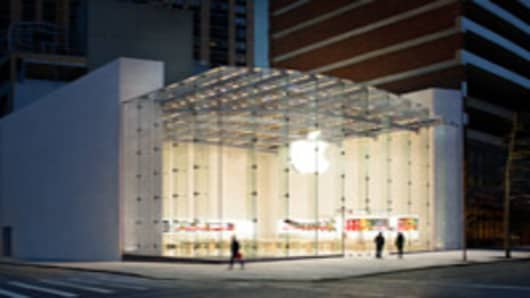Even during the depths of the recession, when it seemed Americans weren't buying anything and most malls were deserted, if you went to the Apple store, you were sure to find a crowd.
Hot new products kept the customers coming through the door even as shoppers were reticent to spend elsewhere. And that hasn't stopped, even between product launches.
A report in the Wall Street Journal argues that Apple is challenging the dominance of department stores, which often serve as so-called anchor tenant that sit on the end of a shopping mall and help draw in shoppers.
Although Apple's popularity is noteworthy, there are other functions anchor tenants fufill that Apple is unlikely to do anytime soon. That said, Apple's stores undeniably remain a hot property for mall owners.
If you think of anchor stores as solely as busy stores that attract shoppers, Apple fits the bill, according to Candace Corlett, president of WSL Strategic Retail in New York.
"The Apple store is busy even between product launches," Corlett said. "It has a consistent flow of the curious and people want to go there and hang out."
And that's critical in this consumer environment.
"Shopping isn't enough to create a buzz and bring people to a mall," Corlett said. She explained that mall operators such as Simon Property Group and Taubman Centers need to have a variety of activities that attract customers.
"Entertainment, terrific food, great places to sit and have a coffee," she explained.
Apple fills this need, but are Apple shoppers likely to spill out of the store and shop the other stores in the mall? Corlett asked. It's tough to say.
An Apple customer is more likely to be affluent, and recent consumer trends have shown that affluent customers have returned to shopping and are buying luxury goods again.
"In the right shopping center, that could be very desirable," said Craig Rowley, vice president and global practice leader at Hay Group.
But beyond traffic generation, there are other less obvious roles anchor tenants play.
Traditional anchors such as Macy's and J.C. Penney do a large amount of local advertising, which helps to publicize the mall for its operators. They also sponsor community events.
"When is the last time you saw Apple do that?" asked Craig Johnson, president of Customer Growth Partners.
Shopping malls also use their long-term leases with their anchor tenants to help secure financing, Johnson said. He said he suspects that it is highly unlikely that Apple would sign a 25-year lease.
Plus, with the exception of Apple's high-profile flagship stores in large cities, the footprint of Apple's stores tends to be much smaller—some 6,000 square feet—than that of the typical department store, which can be more than 150,000 square feet.
And while Apple's flagship stores tend to be larger, they also serve a marketing function for the Apple brand.
"They are billboards for the brand," Johnson said.
That said, it is true that malls have been experimenting with different types of anchor tenants such as sporting goods stores and even discounters such as Targetand Wal-Mart Stores .
Apple did not return a call seeking a comment.
Questions? Comments? Email us at consumernation@cnbc.com. Follow Christina Cheddar Berk on Twitter @ccheddarberk.



